Analyzing Toyota's Supply Chain Management Processes: A Report
VerifiedAdded on 2020/04/29
|12
|3001
|425
Report
AI Summary
This report provides a detailed analysis of Toyota's supply chain management, examining key aspects such as information flow, product flow, cash flow, and return flow. It delves into the company's production planning, including the Toyota Production System (TPS), Just-in-Time (JIT), and Jidoka methodologies. The report explores the Make Process, including Master Production Scheduling (MPS), and the demand forecasting and planning processes utilized by Toyota. Furthermore, the report offers recommendations for improving Toyota's supply chain, focusing on enhancing customer satisfaction and optimizing operational efficiency. The analysis covers the company's strategies to gain competitive advantage, manage cash flow, and handle returned goods. The report highlights the importance of information flow, product flow, and cash flow within Toyota's supply chain, emphasizing the need for accurate demand forecasting and planning. This report is a comprehensive overview of Toyota's supply chain management, which can be helpful for anyone studying business development or supply chain management.
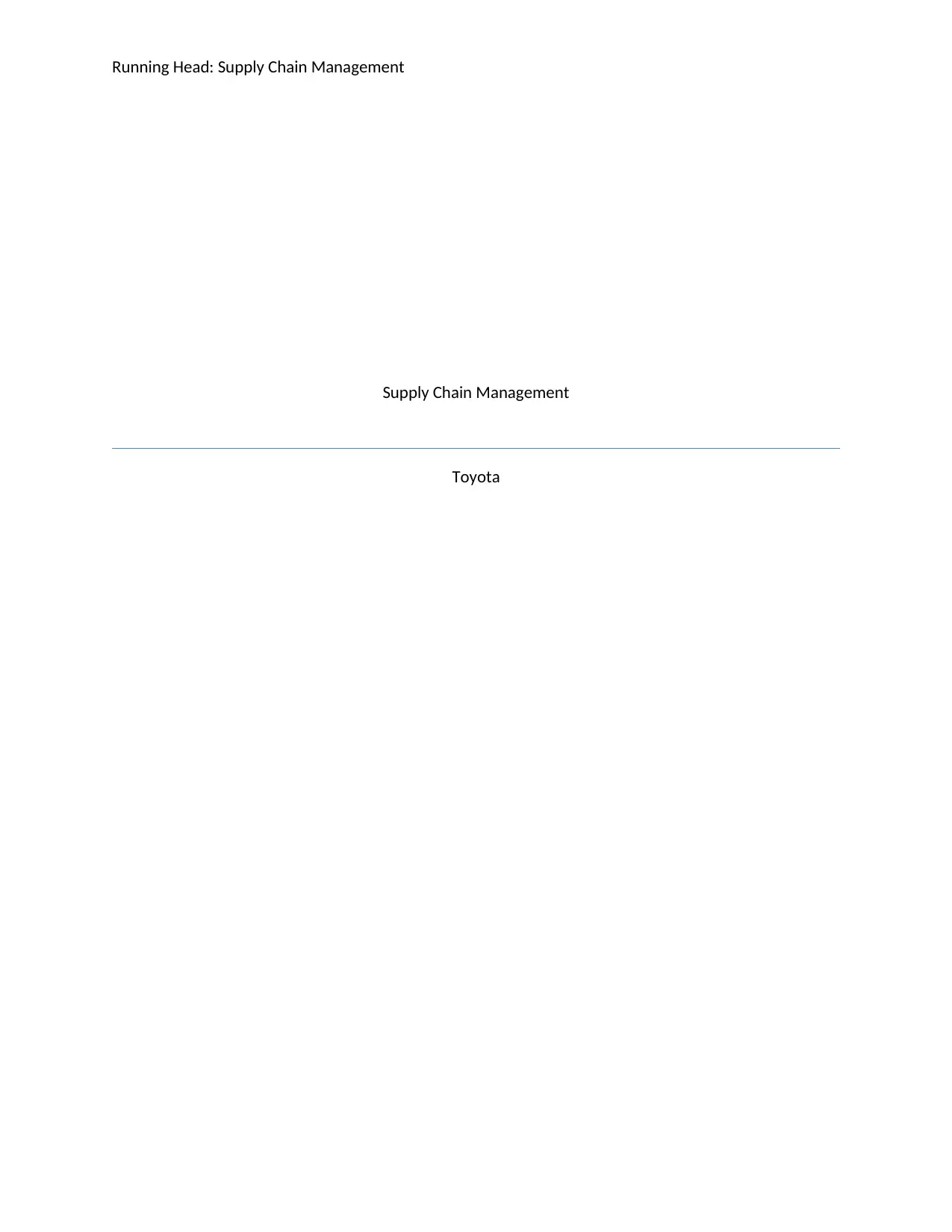
Running Head: Supply Chain Management
Supply Chain Management
Toyota
Supply Chain Management
Toyota
Paraphrase This Document
Need a fresh take? Get an instant paraphrase of this document with our AI Paraphraser
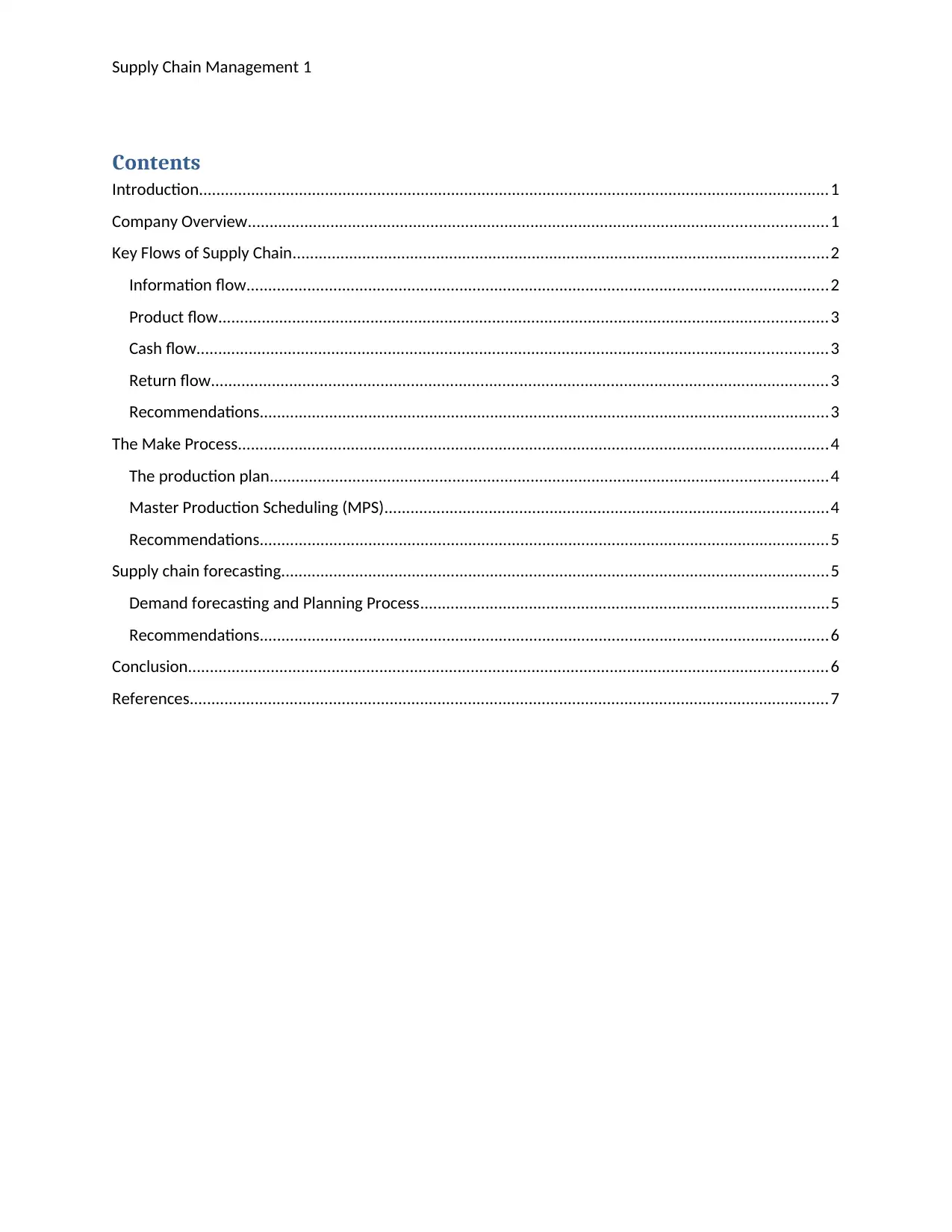
Supply Chain Management 1
Contents
Introduction.................................................................................................................................................1
Company Overview.....................................................................................................................................1
Key Flows of Supply Chain...........................................................................................................................2
Information flow......................................................................................................................................2
Product flow............................................................................................................................................3
Cash flow.................................................................................................................................................3
Return flow..............................................................................................................................................3
Recommendations...................................................................................................................................3
The Make Process........................................................................................................................................4
The production plan................................................................................................................................4
Master Production Scheduling (MPS)......................................................................................................4
Recommendations...................................................................................................................................5
Supply chain forecasting..............................................................................................................................5
Demand forecasting and Planning Process..............................................................................................5
Recommendations...................................................................................................................................6
Conclusion...................................................................................................................................................6
References...................................................................................................................................................7
Contents
Introduction.................................................................................................................................................1
Company Overview.....................................................................................................................................1
Key Flows of Supply Chain...........................................................................................................................2
Information flow......................................................................................................................................2
Product flow............................................................................................................................................3
Cash flow.................................................................................................................................................3
Return flow..............................................................................................................................................3
Recommendations...................................................................................................................................3
The Make Process........................................................................................................................................4
The production plan................................................................................................................................4
Master Production Scheduling (MPS)......................................................................................................4
Recommendations...................................................................................................................................5
Supply chain forecasting..............................................................................................................................5
Demand forecasting and Planning Process..............................................................................................5
Recommendations...................................................................................................................................6
Conclusion...................................................................................................................................................6
References...................................................................................................................................................7
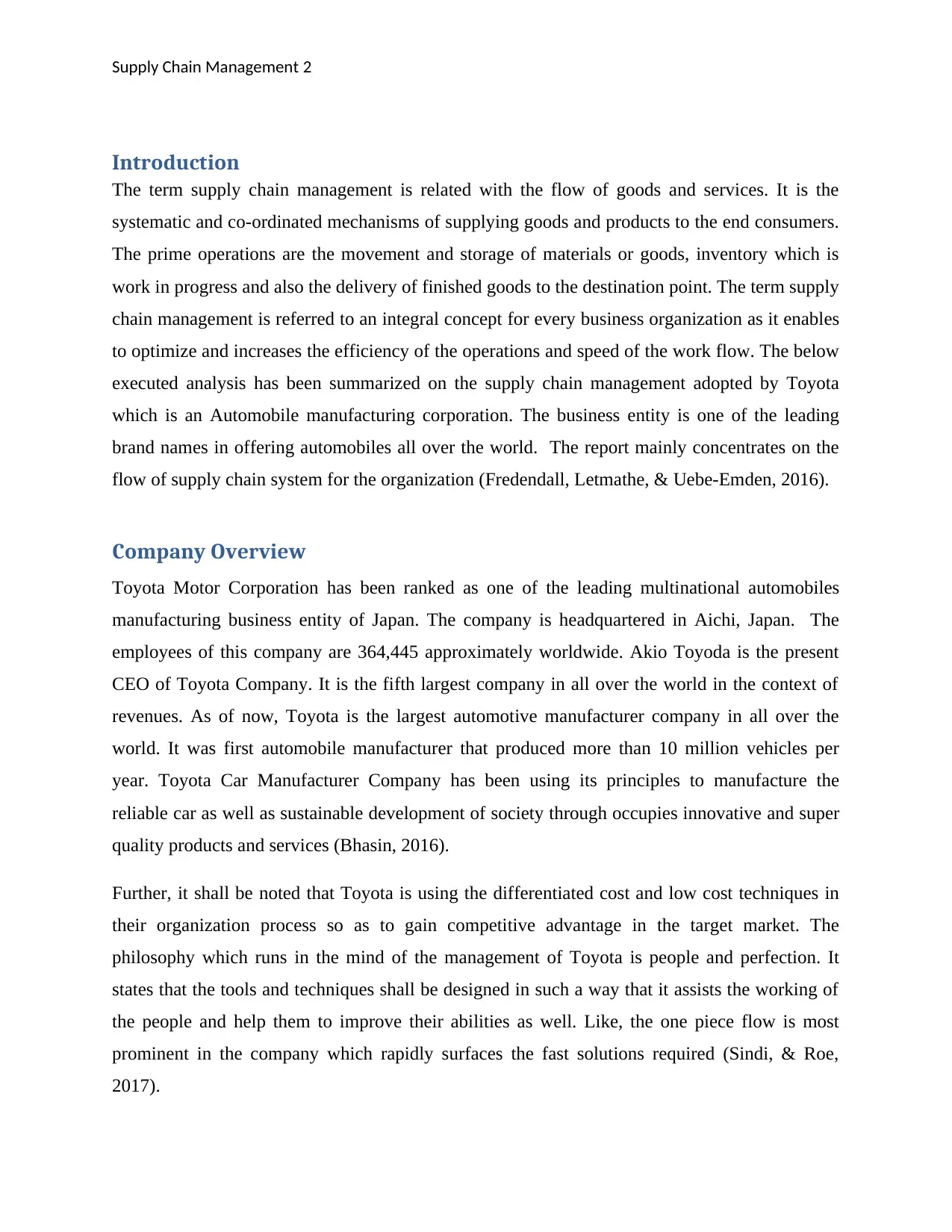
Supply Chain Management 2
Introduction
The term supply chain management is related with the flow of goods and services. It is the
systematic and co-ordinated mechanisms of supplying goods and products to the end consumers.
The prime operations are the movement and storage of materials or goods, inventory which is
work in progress and also the delivery of finished goods to the destination point. The term supply
chain management is referred to an integral concept for every business organization as it enables
to optimize and increases the efficiency of the operations and speed of the work flow. The below
executed analysis has been summarized on the supply chain management adopted by Toyota
which is an Automobile manufacturing corporation. The business entity is one of the leading
brand names in offering automobiles all over the world. The report mainly concentrates on the
flow of supply chain system for the organization (Fredendall, Letmathe, & Uebe-Emden, 2016).
Company Overview
Toyota Motor Corporation has been ranked as one of the leading multinational automobiles
manufacturing business entity of Japan. The company is headquartered in Aichi, Japan. The
employees of this company are 364,445 approximately worldwide. Akio Toyoda is the present
CEO of Toyota Company. It is the fifth largest company in all over the world in the context of
revenues. As of now, Toyota is the largest automotive manufacturer company in all over the
world. It was first automobile manufacturer that produced more than 10 million vehicles per
year. Toyota Car Manufacturer Company has been using its principles to manufacture the
reliable car as well as sustainable development of society through occupies innovative and super
quality products and services (Bhasin, 2016).
Further, it shall be noted that Toyota is using the differentiated cost and low cost techniques in
their organization process so as to gain competitive advantage in the target market. The
philosophy which runs in the mind of the management of Toyota is people and perfection. It
states that the tools and techniques shall be designed in such a way that it assists the working of
the people and help them to improve their abilities as well. Like, the one piece flow is most
prominent in the company which rapidly surfaces the fast solutions required (Sindi, & Roe,
2017).
Introduction
The term supply chain management is related with the flow of goods and services. It is the
systematic and co-ordinated mechanisms of supplying goods and products to the end consumers.
The prime operations are the movement and storage of materials or goods, inventory which is
work in progress and also the delivery of finished goods to the destination point. The term supply
chain management is referred to an integral concept for every business organization as it enables
to optimize and increases the efficiency of the operations and speed of the work flow. The below
executed analysis has been summarized on the supply chain management adopted by Toyota
which is an Automobile manufacturing corporation. The business entity is one of the leading
brand names in offering automobiles all over the world. The report mainly concentrates on the
flow of supply chain system for the organization (Fredendall, Letmathe, & Uebe-Emden, 2016).
Company Overview
Toyota Motor Corporation has been ranked as one of the leading multinational automobiles
manufacturing business entity of Japan. The company is headquartered in Aichi, Japan. The
employees of this company are 364,445 approximately worldwide. Akio Toyoda is the present
CEO of Toyota Company. It is the fifth largest company in all over the world in the context of
revenues. As of now, Toyota is the largest automotive manufacturer company in all over the
world. It was first automobile manufacturer that produced more than 10 million vehicles per
year. Toyota Car Manufacturer Company has been using its principles to manufacture the
reliable car as well as sustainable development of society through occupies innovative and super
quality products and services (Bhasin, 2016).
Further, it shall be noted that Toyota is using the differentiated cost and low cost techniques in
their organization process so as to gain competitive advantage in the target market. The
philosophy which runs in the mind of the management of Toyota is people and perfection. It
states that the tools and techniques shall be designed in such a way that it assists the working of
the people and help them to improve their abilities as well. Like, the one piece flow is most
prominent in the company which rapidly surfaces the fast solutions required (Sindi, & Roe,
2017).
⊘ This is a preview!⊘
Do you want full access?
Subscribe today to unlock all pages.

Trusted by 1+ million students worldwide
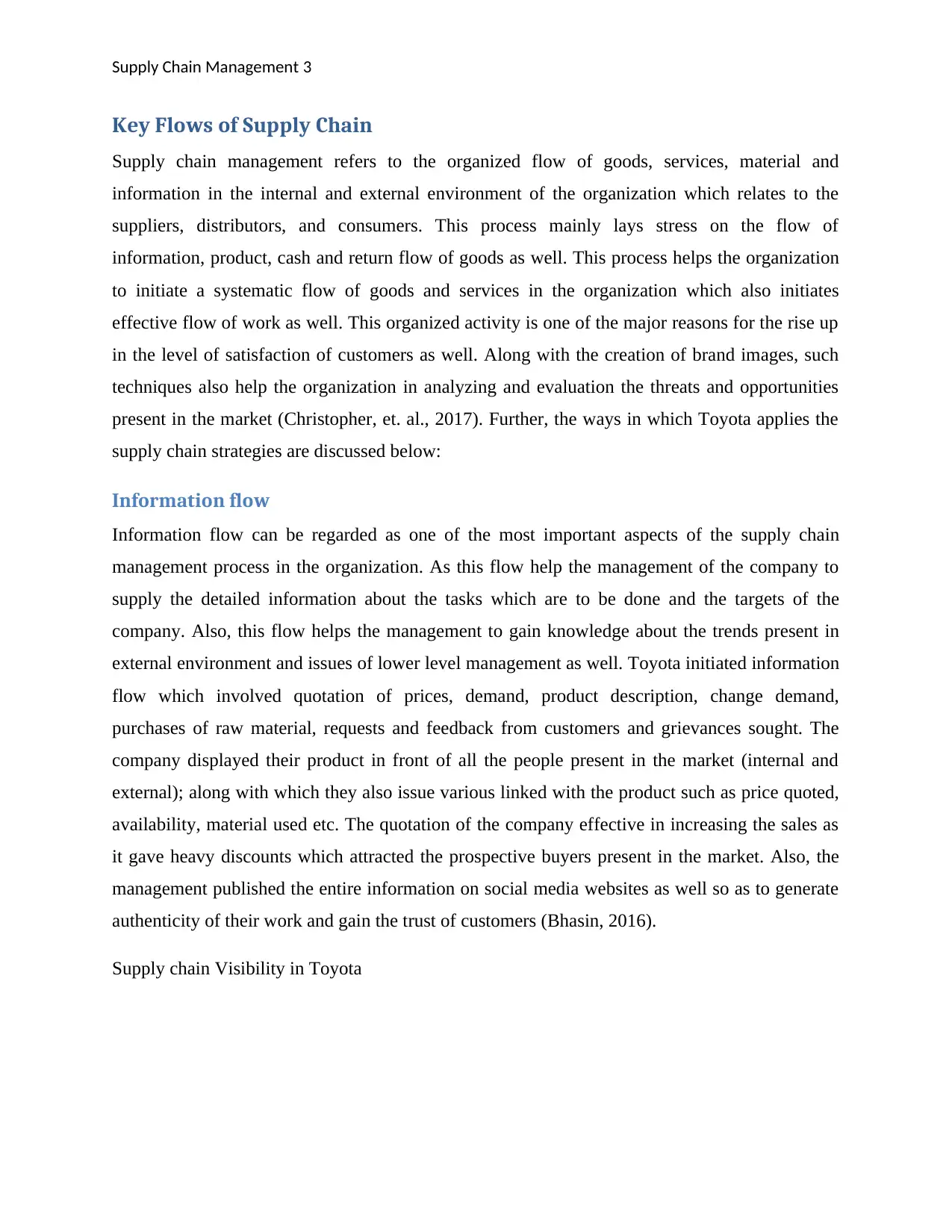
Supply Chain Management 3
Key Flows of Supply Chain
Supply chain management refers to the organized flow of goods, services, material and
information in the internal and external environment of the organization which relates to the
suppliers, distributors, and consumers. This process mainly lays stress on the flow of
information, product, cash and return flow of goods as well. This process helps the organization
to initiate a systematic flow of goods and services in the organization which also initiates
effective flow of work as well. This organized activity is one of the major reasons for the rise up
in the level of satisfaction of customers as well. Along with the creation of brand images, such
techniques also help the organization in analyzing and evaluation the threats and opportunities
present in the market (Christopher, et. al., 2017). Further, the ways in which Toyota applies the
supply chain strategies are discussed below:
Information flow
Information flow can be regarded as one of the most important aspects of the supply chain
management process in the organization. As this flow help the management of the company to
supply the detailed information about the tasks which are to be done and the targets of the
company. Also, this flow helps the management to gain knowledge about the trends present in
external environment and issues of lower level management as well. Toyota initiated information
flow which involved quotation of prices, demand, product description, change demand,
purchases of raw material, requests and feedback from customers and grievances sought. The
company displayed their product in front of all the people present in the market (internal and
external); along with which they also issue various linked with the product such as price quoted,
availability, material used etc. The quotation of the company effective in increasing the sales as
it gave heavy discounts which attracted the prospective buyers present in the market. Also, the
management published the entire information on social media websites as well so as to generate
authenticity of their work and gain the trust of customers (Bhasin, 2016).
Supply chain Visibility in Toyota
Key Flows of Supply Chain
Supply chain management refers to the organized flow of goods, services, material and
information in the internal and external environment of the organization which relates to the
suppliers, distributors, and consumers. This process mainly lays stress on the flow of
information, product, cash and return flow of goods as well. This process helps the organization
to initiate a systematic flow of goods and services in the organization which also initiates
effective flow of work as well. This organized activity is one of the major reasons for the rise up
in the level of satisfaction of customers as well. Along with the creation of brand images, such
techniques also help the organization in analyzing and evaluation the threats and opportunities
present in the market (Christopher, et. al., 2017). Further, the ways in which Toyota applies the
supply chain strategies are discussed below:
Information flow
Information flow can be regarded as one of the most important aspects of the supply chain
management process in the organization. As this flow help the management of the company to
supply the detailed information about the tasks which are to be done and the targets of the
company. Also, this flow helps the management to gain knowledge about the trends present in
external environment and issues of lower level management as well. Toyota initiated information
flow which involved quotation of prices, demand, product description, change demand,
purchases of raw material, requests and feedback from customers and grievances sought. The
company displayed their product in front of all the people present in the market (internal and
external); along with which they also issue various linked with the product such as price quoted,
availability, material used etc. The quotation of the company effective in increasing the sales as
it gave heavy discounts which attracted the prospective buyers present in the market. Also, the
management published the entire information on social media websites as well so as to generate
authenticity of their work and gain the trust of customers (Bhasin, 2016).
Supply chain Visibility in Toyota
Paraphrase This Document
Need a fresh take? Get an instant paraphrase of this document with our AI Paraphraser
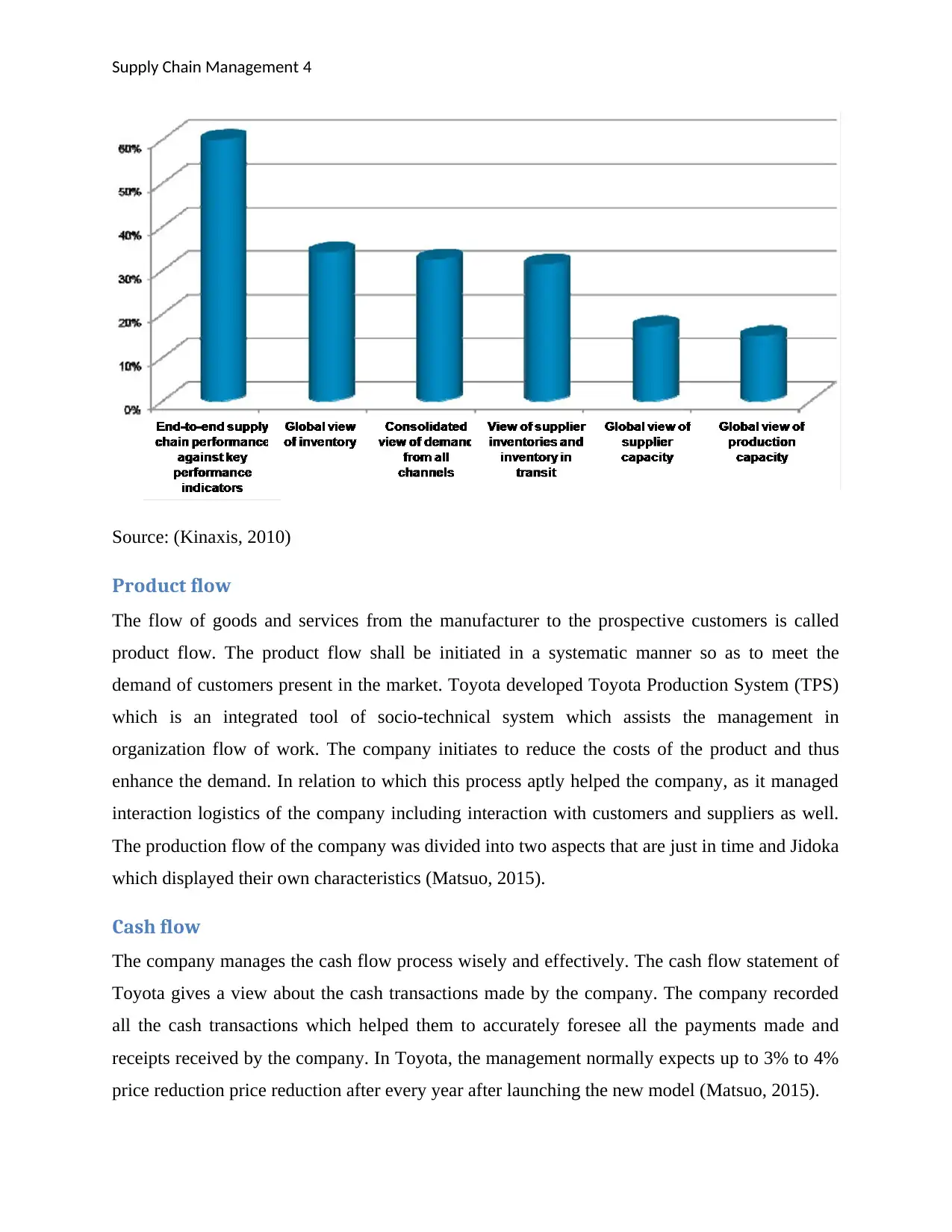
Supply Chain Management 4
Source: (Kinaxis, 2010)
Product flow
The flow of goods and services from the manufacturer to the prospective customers is called
product flow. The product flow shall be initiated in a systematic manner so as to meet the
demand of customers present in the market. Toyota developed Toyota Production System (TPS)
which is an integrated tool of socio-technical system which assists the management in
organization flow of work. The company initiates to reduce the costs of the product and thus
enhance the demand. In relation to which this process aptly helped the company, as it managed
interaction logistics of the company including interaction with customers and suppliers as well.
The production flow of the company was divided into two aspects that are just in time and Jidoka
which displayed their own characteristics (Matsuo, 2015).
Cash flow
The company manages the cash flow process wisely and effectively. The cash flow statement of
Toyota gives a view about the cash transactions made by the company. The company recorded
all the cash transactions which helped them to accurately foresee all the payments made and
receipts received by the company. In Toyota, the management normally expects up to 3% to 4%
price reduction price reduction after every year after launching the new model (Matsuo, 2015).
Source: (Kinaxis, 2010)
Product flow
The flow of goods and services from the manufacturer to the prospective customers is called
product flow. The product flow shall be initiated in a systematic manner so as to meet the
demand of customers present in the market. Toyota developed Toyota Production System (TPS)
which is an integrated tool of socio-technical system which assists the management in
organization flow of work. The company initiates to reduce the costs of the product and thus
enhance the demand. In relation to which this process aptly helped the company, as it managed
interaction logistics of the company including interaction with customers and suppliers as well.
The production flow of the company was divided into two aspects that are just in time and Jidoka
which displayed their own characteristics (Matsuo, 2015).
Cash flow
The company manages the cash flow process wisely and effectively. The cash flow statement of
Toyota gives a view about the cash transactions made by the company. The company recorded
all the cash transactions which helped them to accurately foresee all the payments made and
receipts received by the company. In Toyota, the management normally expects up to 3% to 4%
price reduction price reduction after every year after launching the new model (Matsuo, 2015).
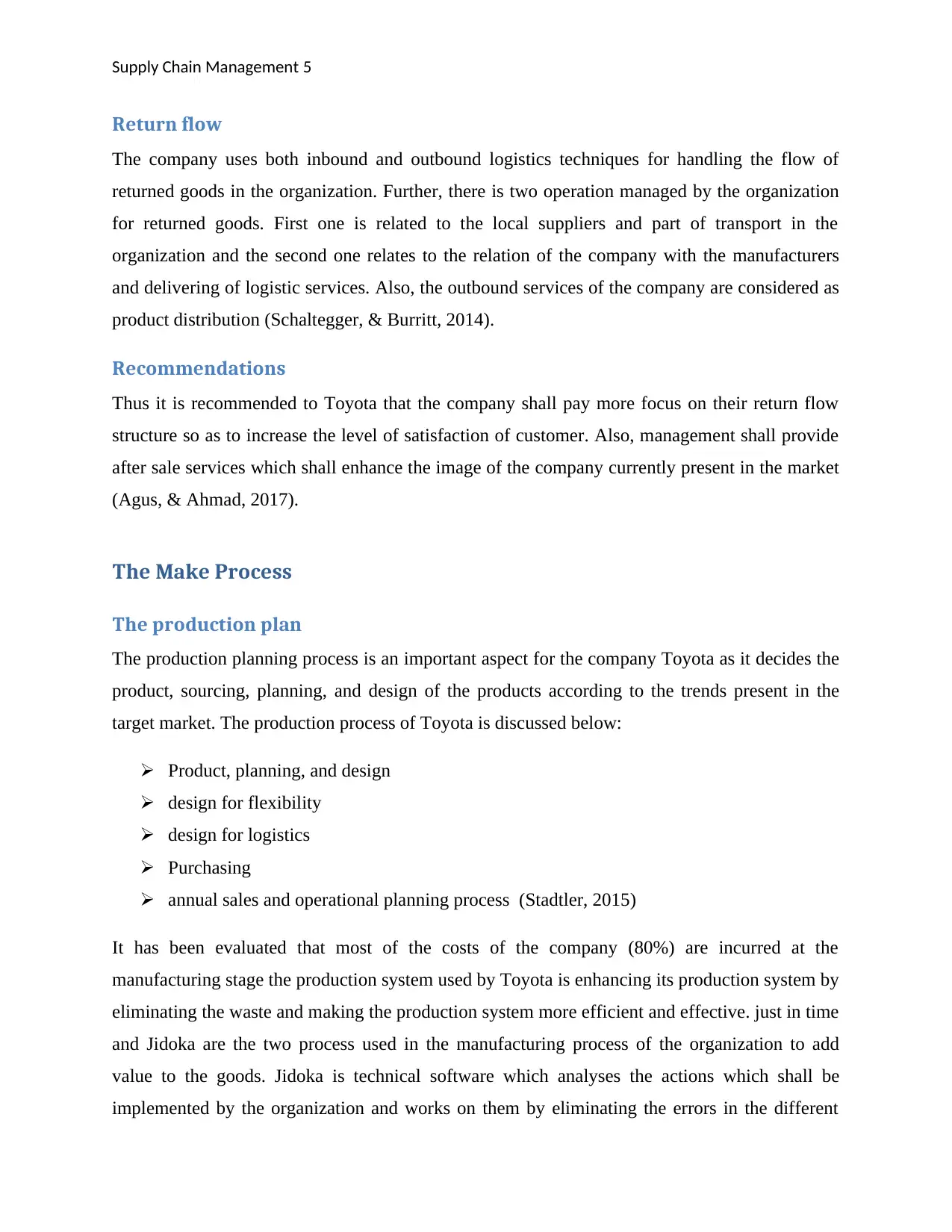
Supply Chain Management 5
Return flow
The company uses both inbound and outbound logistics techniques for handling the flow of
returned goods in the organization. Further, there is two operation managed by the organization
for returned goods. First one is related to the local suppliers and part of transport in the
organization and the second one relates to the relation of the company with the manufacturers
and delivering of logistic services. Also, the outbound services of the company are considered as
product distribution (Schaltegger, & Burritt, 2014).
Recommendations
Thus it is recommended to Toyota that the company shall pay more focus on their return flow
structure so as to increase the level of satisfaction of customer. Also, management shall provide
after sale services which shall enhance the image of the company currently present in the market
(Agus, & Ahmad, 2017).
The Make Process
The production plan
The production planning process is an important aspect for the company Toyota as it decides the
product, sourcing, planning, and design of the products according to the trends present in the
target market. The production process of Toyota is discussed below:
Product, planning, and design
design for flexibility
design for logistics
Purchasing
annual sales and operational planning process (Stadtler, 2015)
It has been evaluated that most of the costs of the company (80%) are incurred at the
manufacturing stage the production system used by Toyota is enhancing its production system by
eliminating the waste and making the production system more efficient and effective. just in time
and Jidoka are the two process used in the manufacturing process of the organization to add
value to the goods. Jidoka is technical software which analyses the actions which shall be
implemented by the organization and works on them by eliminating the errors in the different
Return flow
The company uses both inbound and outbound logistics techniques for handling the flow of
returned goods in the organization. Further, there is two operation managed by the organization
for returned goods. First one is related to the local suppliers and part of transport in the
organization and the second one relates to the relation of the company with the manufacturers
and delivering of logistic services. Also, the outbound services of the company are considered as
product distribution (Schaltegger, & Burritt, 2014).
Recommendations
Thus it is recommended to Toyota that the company shall pay more focus on their return flow
structure so as to increase the level of satisfaction of customer. Also, management shall provide
after sale services which shall enhance the image of the company currently present in the market
(Agus, & Ahmad, 2017).
The Make Process
The production plan
The production planning process is an important aspect for the company Toyota as it decides the
product, sourcing, planning, and design of the products according to the trends present in the
target market. The production process of Toyota is discussed below:
Product, planning, and design
design for flexibility
design for logistics
Purchasing
annual sales and operational planning process (Stadtler, 2015)
It has been evaluated that most of the costs of the company (80%) are incurred at the
manufacturing stage the production system used by Toyota is enhancing its production system by
eliminating the waste and making the production system more efficient and effective. just in time
and Jidoka are the two process used in the manufacturing process of the organization to add
value to the goods. Jidoka is technical software which analyses the actions which shall be
implemented by the organization and works on them by eliminating the errors in the different
⊘ This is a preview!⊘
Do you want full access?
Subscribe today to unlock all pages.

Trusted by 1+ million students worldwide
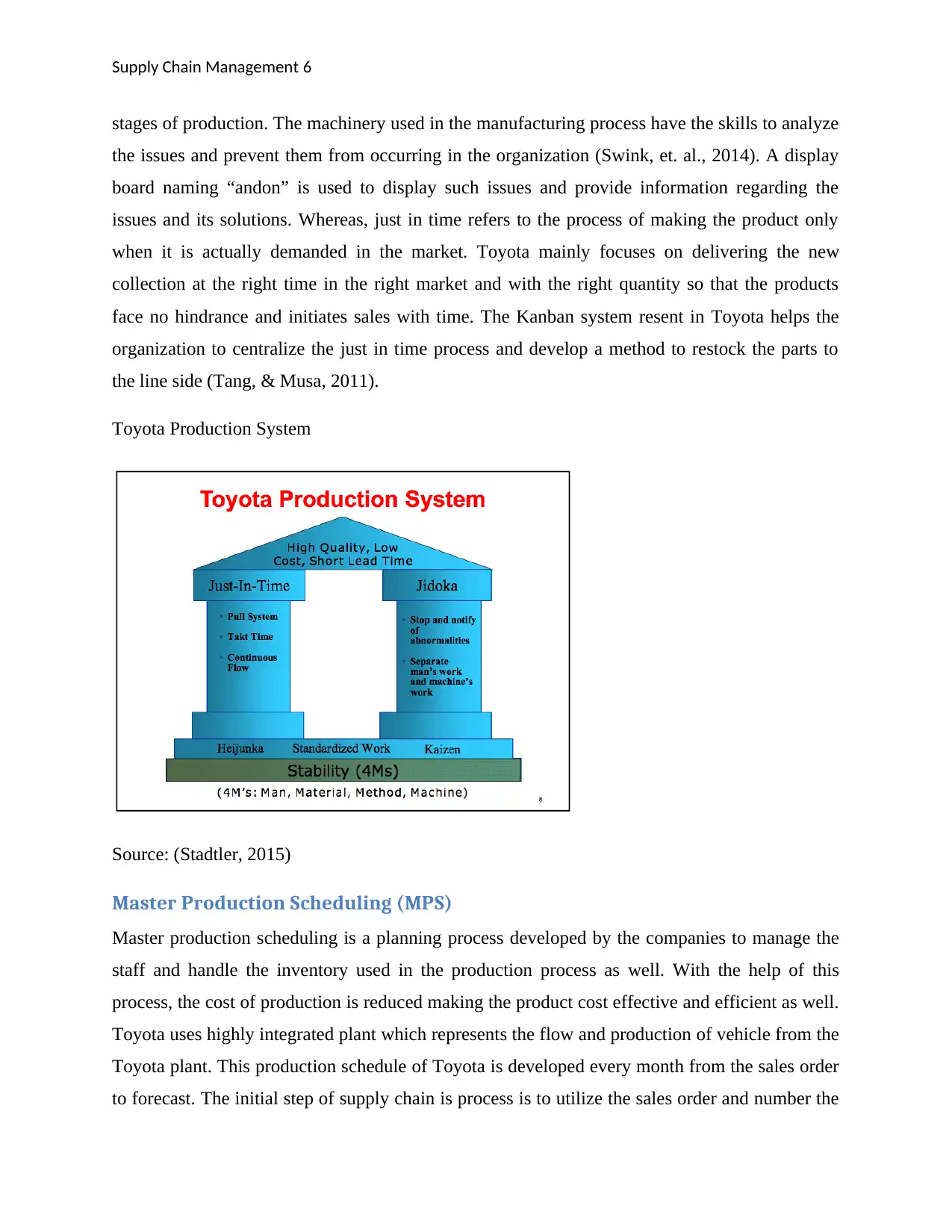
Supply Chain Management 6
stages of production. The machinery used in the manufacturing process have the skills to analyze
the issues and prevent them from occurring in the organization (Swink, et. al., 2014). A display
board naming “andon” is used to display such issues and provide information regarding the
issues and its solutions. Whereas, just in time refers to the process of making the product only
when it is actually demanded in the market. Toyota mainly focuses on delivering the new
collection at the right time in the right market and with the right quantity so that the products
face no hindrance and initiates sales with time. The Kanban system resent in Toyota helps the
organization to centralize the just in time process and develop a method to restock the parts to
the line side (Tang, & Musa, 2011).
Toyota Production System
Source: (Stadtler, 2015)
Master Production Scheduling (MPS)
Master production scheduling is a planning process developed by the companies to manage the
staff and handle the inventory used in the production process as well. With the help of this
process, the cost of production is reduced making the product cost effective and efficient as well.
Toyota uses highly integrated plant which represents the flow and production of vehicle from the
Toyota plant. This production schedule of Toyota is developed every month from the sales order
to forecast. The initial step of supply chain is process is to utilize the sales order and number the
stages of production. The machinery used in the manufacturing process have the skills to analyze
the issues and prevent them from occurring in the organization (Swink, et. al., 2014). A display
board naming “andon” is used to display such issues and provide information regarding the
issues and its solutions. Whereas, just in time refers to the process of making the product only
when it is actually demanded in the market. Toyota mainly focuses on delivering the new
collection at the right time in the right market and with the right quantity so that the products
face no hindrance and initiates sales with time. The Kanban system resent in Toyota helps the
organization to centralize the just in time process and develop a method to restock the parts to
the line side (Tang, & Musa, 2011).
Toyota Production System
Source: (Stadtler, 2015)
Master Production Scheduling (MPS)
Master production scheduling is a planning process developed by the companies to manage the
staff and handle the inventory used in the production process as well. With the help of this
process, the cost of production is reduced making the product cost effective and efficient as well.
Toyota uses highly integrated plant which represents the flow and production of vehicle from the
Toyota plant. This production schedule of Toyota is developed every month from the sales order
to forecast. The initial step of supply chain is process is to utilize the sales order and number the
Paraphrase This Document
Need a fresh take? Get an instant paraphrase of this document with our AI Paraphraser
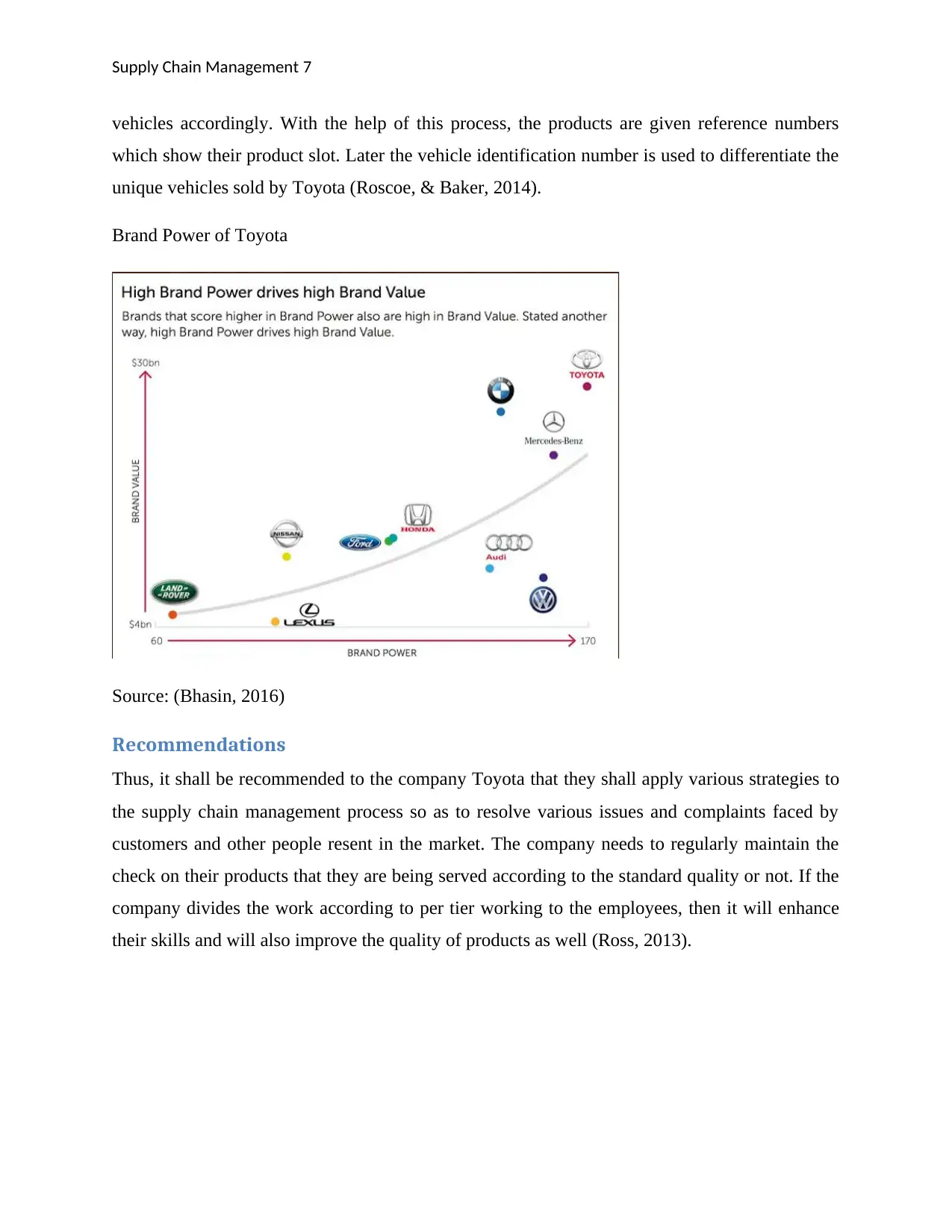
Supply Chain Management 7
vehicles accordingly. With the help of this process, the products are given reference numbers
which show their product slot. Later the vehicle identification number is used to differentiate the
unique vehicles sold by Toyota (Roscoe, & Baker, 2014).
Brand Power of Toyota
Source: (Bhasin, 2016)
Recommendations
Thus, it shall be recommended to the company Toyota that they shall apply various strategies to
the supply chain management process so as to resolve various issues and complaints faced by
customers and other people resent in the market. The company needs to regularly maintain the
check on their products that they are being served according to the standard quality or not. If the
company divides the work according to per tier working to the employees, then it will enhance
their skills and will also improve the quality of products as well (Ross, 2013).
vehicles accordingly. With the help of this process, the products are given reference numbers
which show their product slot. Later the vehicle identification number is used to differentiate the
unique vehicles sold by Toyota (Roscoe, & Baker, 2014).
Brand Power of Toyota
Source: (Bhasin, 2016)
Recommendations
Thus, it shall be recommended to the company Toyota that they shall apply various strategies to
the supply chain management process so as to resolve various issues and complaints faced by
customers and other people resent in the market. The company needs to regularly maintain the
check on their products that they are being served according to the standard quality or not. If the
company divides the work according to per tier working to the employees, then it will enhance
their skills and will also improve the quality of products as well (Ross, 2013).
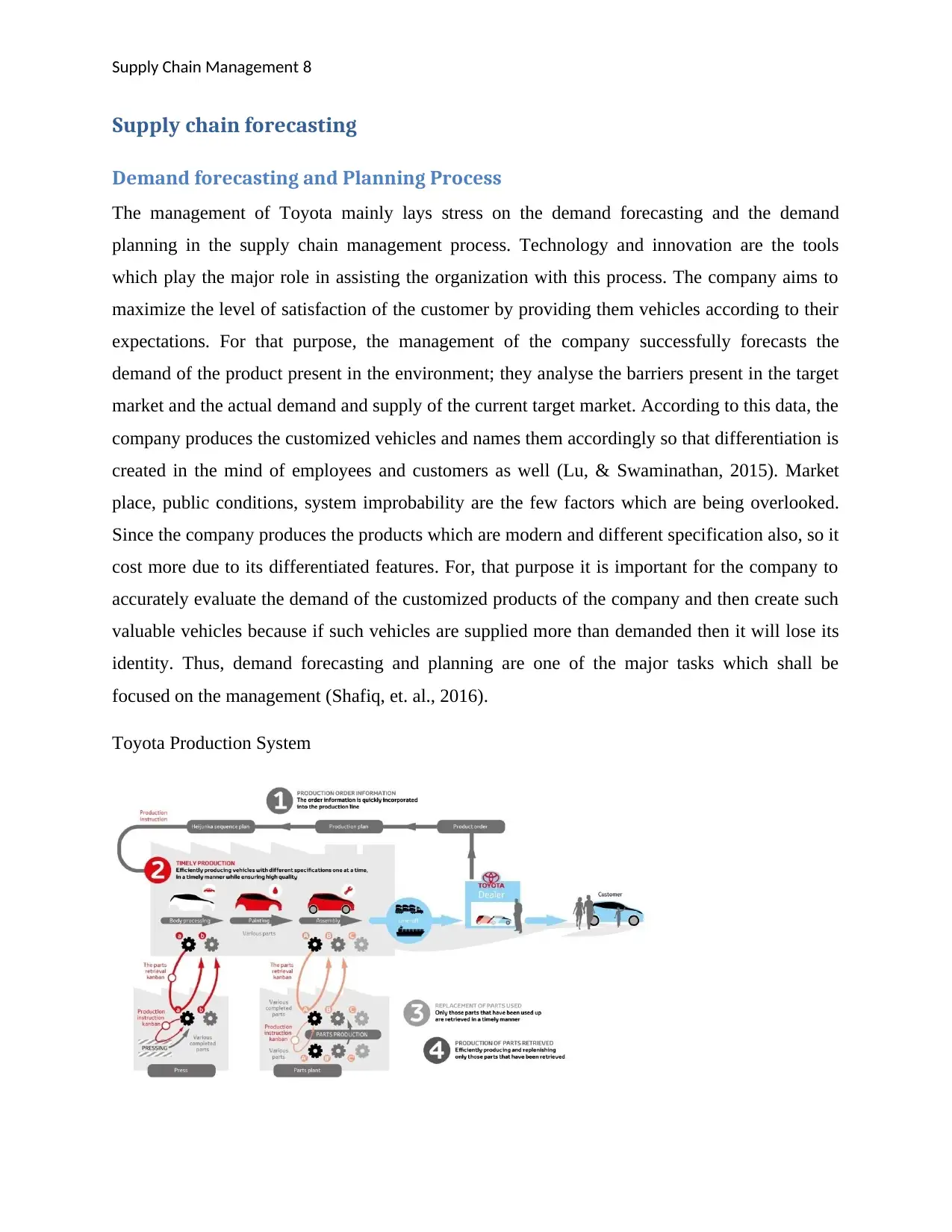
Supply Chain Management 8
Supply chain forecasting
Demand forecasting and Planning Process
The management of Toyota mainly lays stress on the demand forecasting and the demand
planning in the supply chain management process. Technology and innovation are the tools
which play the major role in assisting the organization with this process. The company aims to
maximize the level of satisfaction of the customer by providing them vehicles according to their
expectations. For that purpose, the management of the company successfully forecasts the
demand of the product present in the environment; they analyse the barriers present in the target
market and the actual demand and supply of the current target market. According to this data, the
company produces the customized vehicles and names them accordingly so that differentiation is
created in the mind of employees and customers as well (Lu, & Swaminathan, 2015). Market
place, public conditions, system improbability are the few factors which are being overlooked.
Since the company produces the products which are modern and different specification also, so it
cost more due to its differentiated features. For, that purpose it is important for the company to
accurately evaluate the demand of the customized products of the company and then create such
valuable vehicles because if such vehicles are supplied more than demanded then it will lose its
identity. Thus, demand forecasting and planning are one of the major tasks which shall be
focused on the management (Shafiq, et. al., 2016).
Toyota Production System
Supply chain forecasting
Demand forecasting and Planning Process
The management of Toyota mainly lays stress on the demand forecasting and the demand
planning in the supply chain management process. Technology and innovation are the tools
which play the major role in assisting the organization with this process. The company aims to
maximize the level of satisfaction of the customer by providing them vehicles according to their
expectations. For that purpose, the management of the company successfully forecasts the
demand of the product present in the environment; they analyse the barriers present in the target
market and the actual demand and supply of the current target market. According to this data, the
company produces the customized vehicles and names them accordingly so that differentiation is
created in the mind of employees and customers as well (Lu, & Swaminathan, 2015). Market
place, public conditions, system improbability are the few factors which are being overlooked.
Since the company produces the products which are modern and different specification also, so it
cost more due to its differentiated features. For, that purpose it is important for the company to
accurately evaluate the demand of the customized products of the company and then create such
valuable vehicles because if such vehicles are supplied more than demanded then it will lose its
identity. Thus, demand forecasting and planning are one of the major tasks which shall be
focused on the management (Shafiq, et. al., 2016).
Toyota Production System
⊘ This is a preview!⊘
Do you want full access?
Subscribe today to unlock all pages.

Trusted by 1+ million students worldwide
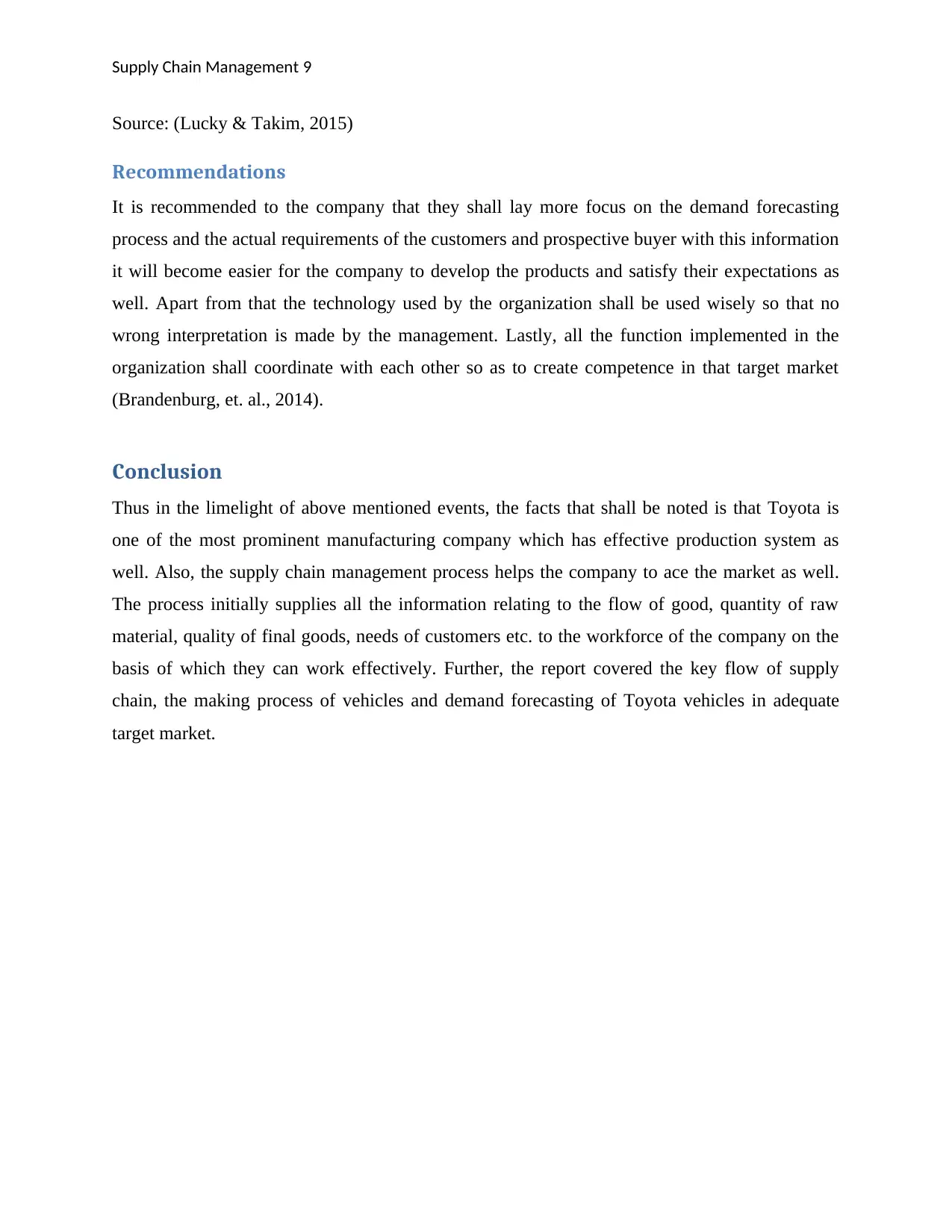
Supply Chain Management 9
Source: (Lucky & Takim, 2015)
Recommendations
It is recommended to the company that they shall lay more focus on the demand forecasting
process and the actual requirements of the customers and prospective buyer with this information
it will become easier for the company to develop the products and satisfy their expectations as
well. Apart from that the technology used by the organization shall be used wisely so that no
wrong interpretation is made by the management. Lastly, all the function implemented in the
organization shall coordinate with each other so as to create competence in that target market
(Brandenburg, et. al., 2014).
Conclusion
Thus in the limelight of above mentioned events, the facts that shall be noted is that Toyota is
one of the most prominent manufacturing company which has effective production system as
well. Also, the supply chain management process helps the company to ace the market as well.
The process initially supplies all the information relating to the flow of good, quantity of raw
material, quality of final goods, needs of customers etc. to the workforce of the company on the
basis of which they can work effectively. Further, the report covered the key flow of supply
chain, the making process of vehicles and demand forecasting of Toyota vehicles in adequate
target market.
Source: (Lucky & Takim, 2015)
Recommendations
It is recommended to the company that they shall lay more focus on the demand forecasting
process and the actual requirements of the customers and prospective buyer with this information
it will become easier for the company to develop the products and satisfy their expectations as
well. Apart from that the technology used by the organization shall be used wisely so that no
wrong interpretation is made by the management. Lastly, all the function implemented in the
organization shall coordinate with each other so as to create competence in that target market
(Brandenburg, et. al., 2014).
Conclusion
Thus in the limelight of above mentioned events, the facts that shall be noted is that Toyota is
one of the most prominent manufacturing company which has effective production system as
well. Also, the supply chain management process helps the company to ace the market as well.
The process initially supplies all the information relating to the flow of good, quantity of raw
material, quality of final goods, needs of customers etc. to the workforce of the company on the
basis of which they can work effectively. Further, the report covered the key flow of supply
chain, the making process of vehicles and demand forecasting of Toyota vehicles in adequate
target market.
Paraphrase This Document
Need a fresh take? Get an instant paraphrase of this document with our AI Paraphraser
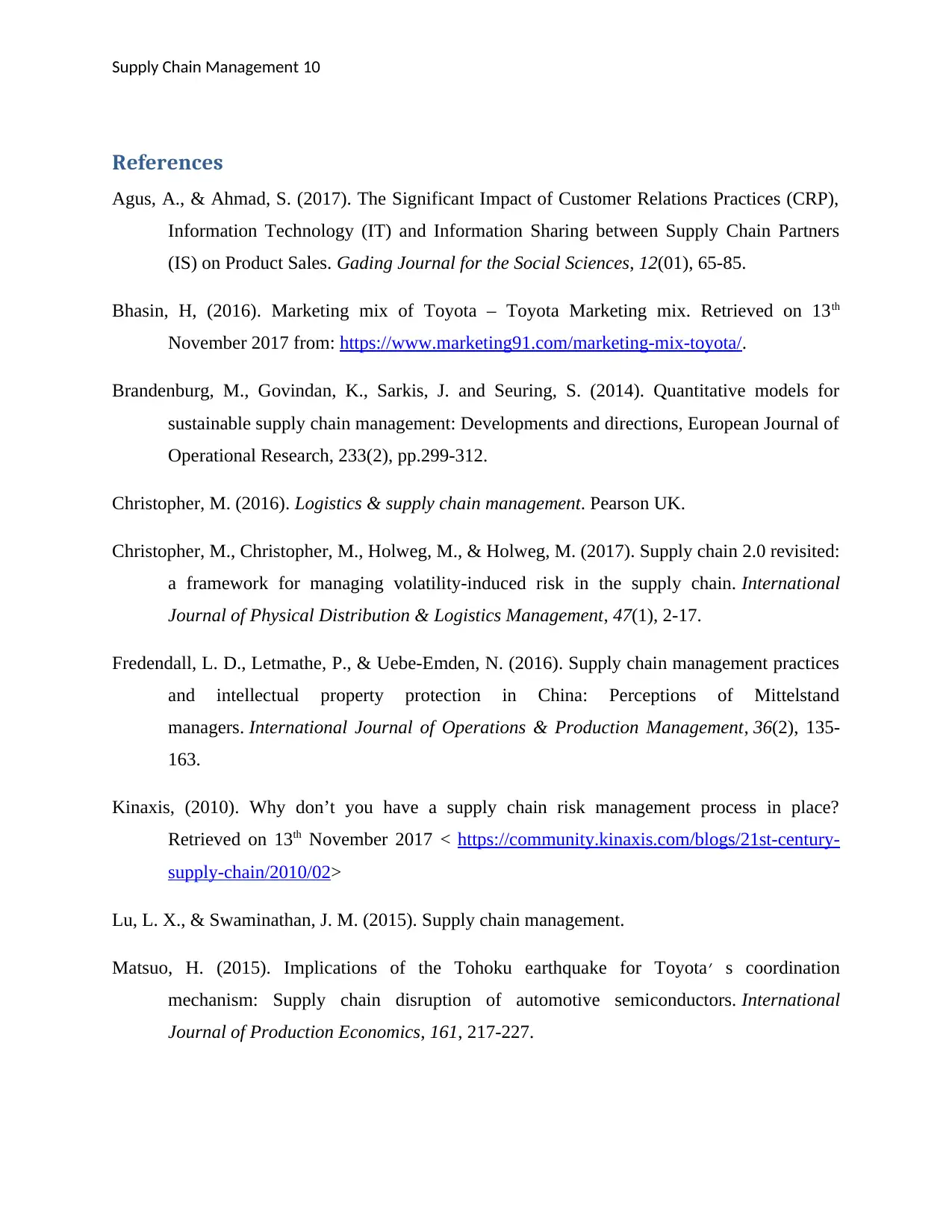
Supply Chain Management 10
References
Agus, A., & Ahmad, S. (2017). The Significant Impact of Customer Relations Practices (CRP),
Information Technology (IT) and Information Sharing between Supply Chain Partners
(IS) on Product Sales. Gading Journal for the Social Sciences, 12(01), 65-85.
Bhasin, H, (2016). Marketing mix of Toyota – Toyota Marketing mix. Retrieved on 13th
November 2017 from: https://www.marketing91.com/marketing-mix-toyota/.
Brandenburg, M., Govindan, K., Sarkis, J. and Seuring, S. (2014). Quantitative models for
sustainable supply chain management: Developments and directions, European Journal of
Operational Research, 233(2), pp.299-312.
Christopher, M. (2016). Logistics & supply chain management. Pearson UK.
Christopher, M., Christopher, M., Holweg, M., & Holweg, M. (2017). Supply chain 2.0 revisited:
a framework for managing volatility-induced risk in the supply chain. International
Journal of Physical Distribution & Logistics Management, 47(1), 2-17.
Fredendall, L. D., Letmathe, P., & Uebe-Emden, N. (2016). Supply chain management practices
and intellectual property protection in China: Perceptions of Mittelstand
managers. International Journal of Operations & Production Management, 36(2), 135-
163.
Kinaxis, (2010). Why don’t you have a supply chain risk management process in place?
Retrieved on 13th November 2017 < https://community.kinaxis.com/blogs/21st-century-
supply-chain/2010/02>
Lu, L. X., & Swaminathan, J. M. (2015). Supply chain management.
Matsuo, H. (2015). Implications of the Tohoku earthquake for Toyota׳ s coordination
mechanism: Supply chain disruption of automotive semiconductors. International
Journal of Production Economics, 161, 217-227.
References
Agus, A., & Ahmad, S. (2017). The Significant Impact of Customer Relations Practices (CRP),
Information Technology (IT) and Information Sharing between Supply Chain Partners
(IS) on Product Sales. Gading Journal for the Social Sciences, 12(01), 65-85.
Bhasin, H, (2016). Marketing mix of Toyota – Toyota Marketing mix. Retrieved on 13th
November 2017 from: https://www.marketing91.com/marketing-mix-toyota/.
Brandenburg, M., Govindan, K., Sarkis, J. and Seuring, S. (2014). Quantitative models for
sustainable supply chain management: Developments and directions, European Journal of
Operational Research, 233(2), pp.299-312.
Christopher, M. (2016). Logistics & supply chain management. Pearson UK.
Christopher, M., Christopher, M., Holweg, M., & Holweg, M. (2017). Supply chain 2.0 revisited:
a framework for managing volatility-induced risk in the supply chain. International
Journal of Physical Distribution & Logistics Management, 47(1), 2-17.
Fredendall, L. D., Letmathe, P., & Uebe-Emden, N. (2016). Supply chain management practices
and intellectual property protection in China: Perceptions of Mittelstand
managers. International Journal of Operations & Production Management, 36(2), 135-
163.
Kinaxis, (2010). Why don’t you have a supply chain risk management process in place?
Retrieved on 13th November 2017 < https://community.kinaxis.com/blogs/21st-century-
supply-chain/2010/02>
Lu, L. X., & Swaminathan, J. M. (2015). Supply chain management.
Matsuo, H. (2015). Implications of the Tohoku earthquake for Toyota׳ s coordination
mechanism: Supply chain disruption of automotive semiconductors. International
Journal of Production Economics, 161, 217-227.
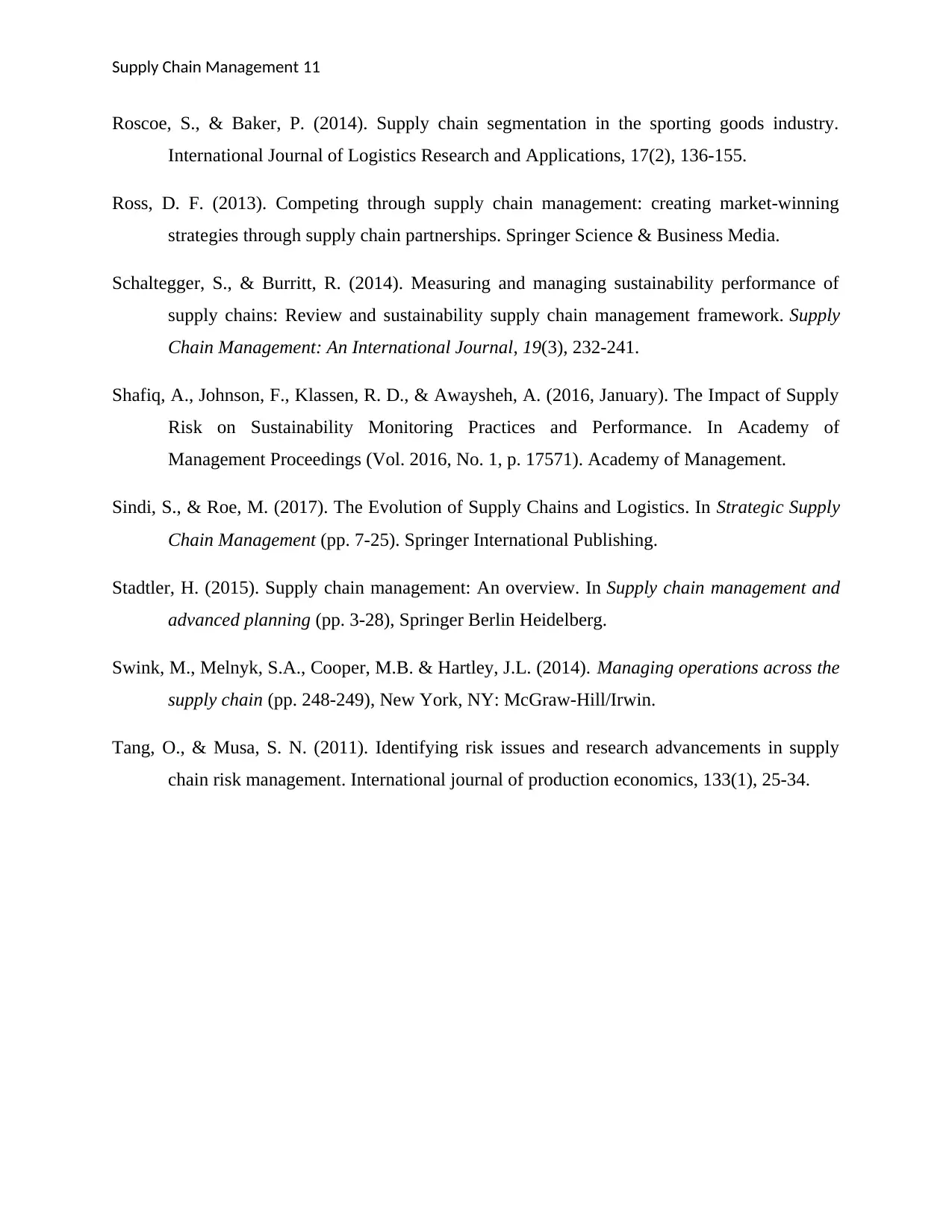
Supply Chain Management 11
Roscoe, S., & Baker, P. (2014). Supply chain segmentation in the sporting goods industry.
International Journal of Logistics Research and Applications, 17(2), 136-155.
Ross, D. F. (2013). Competing through supply chain management: creating market-winning
strategies through supply chain partnerships. Springer Science & Business Media.
Schaltegger, S., & Burritt, R. (2014). Measuring and managing sustainability performance of
supply chains: Review and sustainability supply chain management framework. Supply
Chain Management: An International Journal, 19(3), 232-241.
Shafiq, A., Johnson, F., Klassen, R. D., & Awaysheh, A. (2016, January). The Impact of Supply
Risk on Sustainability Monitoring Practices and Performance. In Academy of
Management Proceedings (Vol. 2016, No. 1, p. 17571). Academy of Management.
Sindi, S., & Roe, M. (2017). The Evolution of Supply Chains and Logistics. In Strategic Supply
Chain Management (pp. 7-25). Springer International Publishing.
Stadtler, H. (2015). Supply chain management: An overview. In Supply chain management and
advanced planning (pp. 3-28), Springer Berlin Heidelberg.
Swink, M., Melnyk, S.A., Cooper, M.B. & Hartley, J.L. (2014). Managing operations across the
supply chain (pp. 248-249), New York, NY: McGraw-Hill/Irwin.
Tang, O., & Musa, S. N. (2011). Identifying risk issues and research advancements in supply
chain risk management. International journal of production economics, 133(1), 25-34.
Roscoe, S., & Baker, P. (2014). Supply chain segmentation in the sporting goods industry.
International Journal of Logistics Research and Applications, 17(2), 136-155.
Ross, D. F. (2013). Competing through supply chain management: creating market-winning
strategies through supply chain partnerships. Springer Science & Business Media.
Schaltegger, S., & Burritt, R. (2014). Measuring and managing sustainability performance of
supply chains: Review and sustainability supply chain management framework. Supply
Chain Management: An International Journal, 19(3), 232-241.
Shafiq, A., Johnson, F., Klassen, R. D., & Awaysheh, A. (2016, January). The Impact of Supply
Risk on Sustainability Monitoring Practices and Performance. In Academy of
Management Proceedings (Vol. 2016, No. 1, p. 17571). Academy of Management.
Sindi, S., & Roe, M. (2017). The Evolution of Supply Chains and Logistics. In Strategic Supply
Chain Management (pp. 7-25). Springer International Publishing.
Stadtler, H. (2015). Supply chain management: An overview. In Supply chain management and
advanced planning (pp. 3-28), Springer Berlin Heidelberg.
Swink, M., Melnyk, S.A., Cooper, M.B. & Hartley, J.L. (2014). Managing operations across the
supply chain (pp. 248-249), New York, NY: McGraw-Hill/Irwin.
Tang, O., & Musa, S. N. (2011). Identifying risk issues and research advancements in supply
chain risk management. International journal of production economics, 133(1), 25-34.
⊘ This is a preview!⊘
Do you want full access?
Subscribe today to unlock all pages.

Trusted by 1+ million students worldwide
1 out of 12
Related Documents
Your All-in-One AI-Powered Toolkit for Academic Success.
+13062052269
info@desklib.com
Available 24*7 on WhatsApp / Email
![[object Object]](/_next/static/media/star-bottom.7253800d.svg)
Unlock your academic potential
Copyright © 2020–2025 A2Z Services. All Rights Reserved. Developed and managed by ZUCOL.




